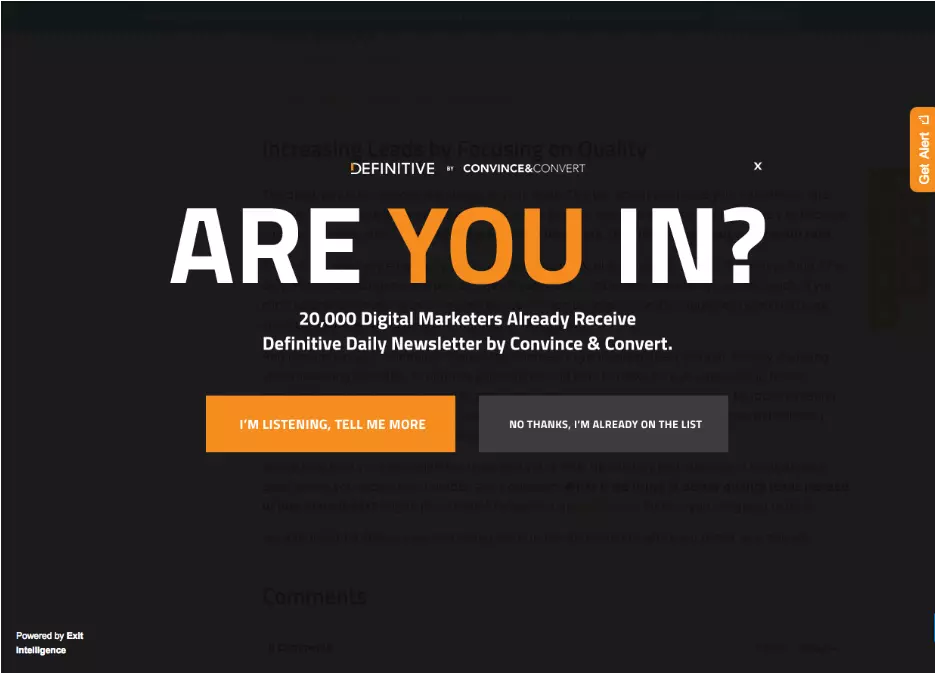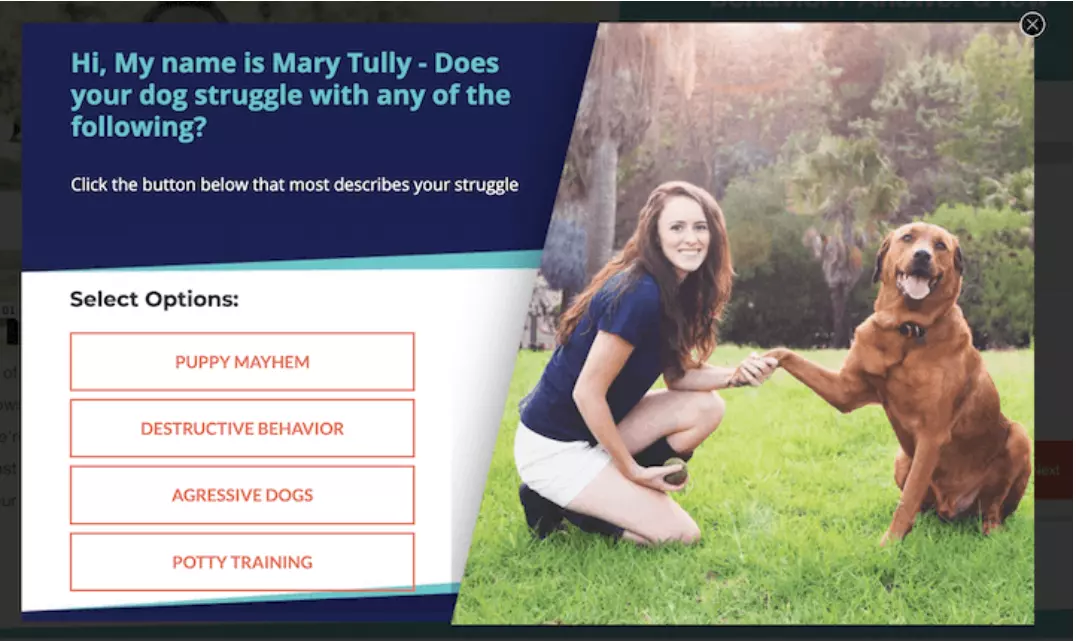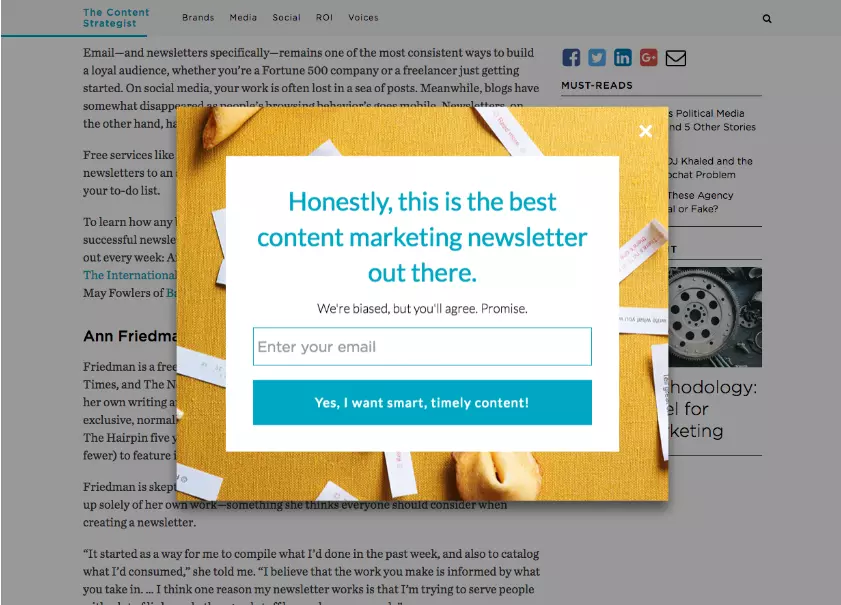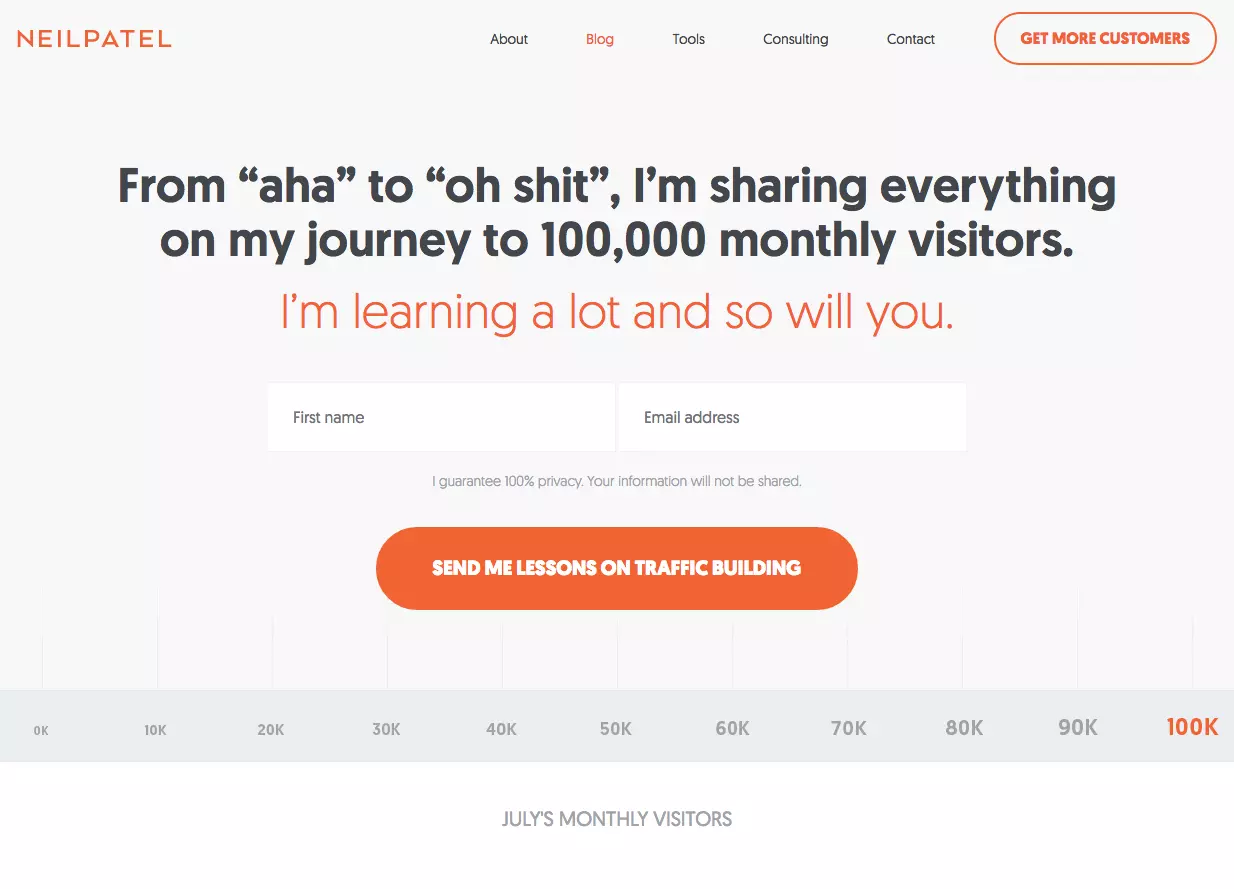Did you know that a whopping 42.7% of internet users worldwide report using an ad blocker? As publishers, we feel the pinch. Monetizing content in a world where the “X” button is a user’s best friend can feel like an uphill battle. But what if we told you that there’s a type of ad that, when used correctly, can provide significant revenues without hampering the user experience? Yes, we’re talking about pop-up ads.
Now, we know what you’re thinking. “Pop-up ads? Really?” But bear with us. While pop-up ads have been notorious for being disruptive, they’ve evolved over the years. Their modern, sophisticated versions can be a game-changer for publishers when integrated thoughtfully into a programmatic advertising strategy.
So, what are pop-up ads, and how can you, as a publisher, make the most of them? Let’s dive in.
Table of Contents
- What Are Pop-Up Ads?
- The Value of Pop-Up Ads for Publishers
- Examples of Effective Pop-Ups for Publishers
- Creating Effective Pop-Up Ads: A Step-by-Step Guide
- Metrics to Track Pop-Up Ad Performance
- Respecting User Preferences and Privacy Regulations
- Keeping SEO Intact While Using Pop-Up Ads
- Navigating Ad Blockers and Ensuring Your Pop-Up Ads Reach Your Audience
- Understanding the Value of Pop-Up Ads for Publishers
What Are Pop-Up Ads?
💡 Pop-up ads are a type of ad that appears on top of a web page while you are browsing.
Think about a time when you’re deep into reading an interesting article online, and suddenly, a box appears on your screen, asking for your attention. That unexpected interruption is a pop-up ad in action.
Pop-up ads can be a useful tool for online publishers. They’re designed to grab a user’s attention and can be effective in increasing interaction and ad revenue.
But it doesn’t always work out perfectly. We’ve all been bothered by a pop-up ad that comes at the wrong time. That’s why creating a good pop-up ad is important. A well-made, well-timed pop-up can get your users interested. But if it’s not done right, it can just make users want to close it as fast as they can.
The trick here is to make your pop-up noticeable but not overly annoying. Finding this balance is the key to effectively using pop-up ads without making your users unhappy.
The Value of Pop-Up Ads for Publishers
“Why bother with pop-up ads?” you may ask. Here are three compelling reasons why they can add value to your publishing strategy:
- Commanding Attention: Pop-up ads have a knack for stealing the spotlight. Unlike banner ads that rest modestly on the side, pop-ups make a grand entrance onto your user’s screen. Yes, they are hard to ignore, but compelling content makes users more likely to engage.
- Boosting User Engagement: Pop-ups have a secret superpower – they can prompt users to take actions they might not have considered otherwise. Whether subscribing to your newsletter, participating in a survey, or exploring a promotional offer, pop-ups add an interactive touch that encourages users to connect with your site more meaningfully.
- Generating Revenue: Here’s the big one. Pop-up ads often command higher CPMs (Cost per thousand impressions) than standard display ads. By integrating them wisely into your programmatic advertising strategy, they can significantly bump up your ad revenue. And with the power to target specific user segments, you can ensure your pop-up ads resonate with the right audience, optimizing your returns.
Remember the fine line we talked about? Crossing it might lead to miffed users and increased bounce rates. But with careful planning and execution, pop-up ads can reap substantial rewards.
Examples of Effective Pop-Ups for Publishers
Let’s look at some successful pop-up examples:
1. Convince & Convert: Engaging and Inviting
Convince & Convert uses an overlay-style scroll pop-up that immediately draws the visitor’s attention with the phrase, “Are you in?”. This strategy effectively entices professionals and aspiring digital marketers to join their communities.

2. Tully’s Training: Addressing Pain Points
Tully’s Training presents a friendly introduction followed by four common dog training issues in its pop-up. The interactive nature of the options makes it engaging.

3. Contently: Power of Value Proposition
Contently uses a timed pop-up that boasts of “the best content newsletter out there”, creating a strong value proposition that entices users.

4. NeilPatel: Embodying Best Practices
Neil Patel’s pop-up showcases effective strategies, including a benefit-oriented CTA and social proof. A blueprint for boosting engagement and conversions.

5. Coschedule: Exit-Intent Strategy
Coschedule’s pop-up uses exit-intent technology to offer a value proposition for users about to leave. Publishers can offer incentives like subscription discounts to retain users.

These examples showcase diverse and effective pop-up designs for publishers monetizing programmatically. The best strategy will depend on your needs, goals, and audience preferences.
Creating Effective Pop-Up Ads: A Step-by-Step Guide
Creating successful pop-up ads is an art that blends good design, precise targeting, and appropriate timing. Here is how to approach creating pop-up ads while focusing on several key areas:
- Understanding Your Audience:
- To create pop-up ads that resonate, start by analyzing your users’ behaviors and preferences through an analytics tool.
- Segment your users based on these insights to tailor your approach for different groups.
- Once you’ve segmented your audience, design and deliver custom pop-up ads that meet each group’s unique needs and preferences.
- Timing Your Pop-Ups Effectively:
- Instead of presenting users with a pop-up ad as soon as they land on your page, experiment with different timing strategies.
- Consider setting your pop-ups to appear after a user has spent a certain amount of time on your page or has scrolled to a specific point.
- Keep track of how users engage with pop-ups at different times, and use this data to refine your strategy.
- Ensuring Accessibility:
- Always include a clear and easy-to-find “X” or “close” button in your pop-up ads.
- Regularly test your pop-ups across different devices and browsers to ensure the close button is always functional and visible.
- Seek and respond to feedback about your pop-up designs to make continual improvements.
- Prioritizing User Experience:
- Spend time on the design of the layout of your pop-up ads to ensure they’re visually pleasing and easy to navigate.
- Keep your website running smoothly by optimizing pop-up load times, which can otherwise slow down your site and frustrate users.
- Collect and respond to user feedback regularly to continuously improve your pop-up strategy.
Remember, pop-up ads are just one component of your overall programmatic advertising strategy. They should work in concert with your other advertising efforts, not in isolation.
Metrics to Track Pop-Up Ad Performance
Now that you have your pop-up ad game plan in place, how do you measure success? Tracking the right metrics can give you insights into your pop-up ad performance and guide future strategies.
Here’s a list of key metrics and what they can tell you:
- Viewability: This metric measures whether users actually saw your ad. High viewability means your pop-up ad reaches your audience and grabs their attention. Advertisers love it, and they will eagerly pay you more.How to track it: Use tools like Google Analytics to track the viewability of your pop-up ads. Pay attention to how long the ad remains in view and the percentage of the ad in view.
- Click-through Rate (CTR): CTR is the ratio of users who click on your pop-up ad to the total number of users who view the ad. A high CTR indicates that your ad is relevant and enticing to users.How to track it: Again, you can use your site’s Google Analytics or any other analytics software to track this metric.
- Bounce Rate: This is the percentage of visitors who navigate away from the site after viewing only one page. A high bounce rate could indicate that your pop-up ad annoys users or hinders their website experience.How to track it: You can monitor the bounce rate of your site in your website analytics. If the bounce rate increases after implementing pop-up ads, it might be time to reassess your strategy.
Remember, the goal isn’t just to track these metrics but to learn from them. Analyze these numbers regularly, identify trends, and adjust your strategy to improve your pop-up ad performance continually.
Respecting User Preferences and Privacy Regulations
Pop-up ads can be a powerful engagement and revenue booster. However, using them should not come at the cost of breaching user preferences or privacy regulations. Your users’ trust is vital, and respecting privacy laws is a non-negotiable part of building that trust. Here’s your roadmap:
1. Compliance with Privacy Laws: Global privacy regulations such as GDPR and CCPA necessitate compliance in your advertising strategies, pop-up ads included.
Your Game Plan:
- Ensure explicit user consent before collecting any personal data through your pop-up ads.
- Be transparent about what data you’re gathering, its purpose, and how you’re using it.
- Facilitate an uncomplicated process for users to withdraw their consent to data collection.
2. Empower Users to Control Their Experience: If users prefer an ad-free experience, they should have an effortless way to make that choice.
Your Game Plan:
- Incorporate a simple, easy-to-find option for users to opt out of pop-up ads.
- Ensure the user experience remains consistent and functional irrespective of their ad preferences.
Keeping SEO Intact While Using Pop-Up Ads
Pop-up ads, if not designed and implemented correctly, can harm your website’s SEO. Google’s algorithm values the user experience above all else, and intrusive pop-ups can negatively affect this experience. Here’s how you can use pop-up ads while keeping your SEO intact:
1. Ensure Fast Loading Speeds: Slow-loading pop-up ads can increase your site’s overall loading time, impacting your SEO negatively as Google values fast-loading websites.
Your Game Plan:
- Optimize your pop-up ads for fast loading. Compress images and minimize the use of heavy scripts.
- Regularly test your website’s speed with tools like Google’s PageSpeed Insights. If there’s a slowdown after implementing pop-ups, you may need to optimize further.
2. Make Pop-Ups Mobile-Friendly: With mobile-first indexing, Google primarily uses a site’s mobile version for ranking. If your pop-up ads hinder the mobile user experience, it could negatively impact your SEO.
Your Game Plan:
- Design responsive pop-up ads that adapt to different screen sizes.
- Test your pop-ups on various devices to ensure they don’t obstruct content or navigation on smaller screens.
3. Ensure Crawlability: If your pop-up ads block search engine bots from crawling your website, it can impact your SEO.
Your Game Plan:
- Make sure your pop-up ads don’t block critical content on your website from search engine bots.
- Regularly test your website’s crawlability with tools like Google Search Console.
Navigating Ad Blockers and Ensuring Your Pop-Up Ads Reach Your Audience
As ad blockers become increasingly popular among internet users, publishers must learn to navigate around these tools to ensure their pop-up ads reach their intended audience. Here’s how you can do it:
1. Appeal to Users’ Emotions: Users are more likely to whitelist your site from their ad blocker if they feel a connection to your content.
Your Game Plan:
- Craft compelling content that resonates with your users and builds an emotional connection.
- Politely ask users to whitelist your site because ad revenue helps you continue providing quality content.
2. Employ Anti-Ad Block Technology: Some services can help you bypass ad blockers and deliver your ads to your audience.
Your Game Plan:
- Research and invest in reliable anti-ad block technology.
- Monitor the performance of your ads regularly to ensure they’re reaching your audience.
3. Use Acceptable Ads Programs: Some ad blockers allow “non-intrusive” ads to be displayed, provided they meet certain criteria.
Your Game Plan:
- Familiarize yourself with the criteria for non-intrusive ads and design your pop-ups accordingly.
- Consider participating in Acceptable Ads programs to reach users even when they’re using ad blockers.
Understanding the Value of Pop-Up Ads for Publishers
Pop-up ads serve as more than just supplementary income; they offer a way to deliver pertinent content and add value to your audience. With careful management informed by a thorough understanding of your audience’s preferences and habits, pop-up ads can greatly enrich user interaction with your platform.
Elevating Ad Management with Automatad
Of course, pop-up ads are just one aspect of the broader advertising landscape for publishers. Beyond individual ads, it’s the comprehensive ad management strategy that can really make a difference. Unlocking the full potential of your ad inventory, optimizing ad performance, increasing revenue, and maintaining full transparency – these are all targets that a well-rounded ad management solution can help you hit.
Automatad’s unique offering integrates these advanced features, tailored for publishers seeking to fully exploit their ad inventory potential. Ready to revolutionize your ad management approach? Get in touch with Automatad today.























